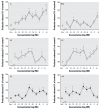Alkylphenol xenoestrogens with varying carbon chain lengths differentially and potently activate signaling and functional responses in GH3/B6/F10 somatomammotropes
- PMID: 19479013
- PMCID: PMC2685833
- DOI: 10.1289/ehp.0800182
Alkylphenol xenoestrogens with varying carbon chain lengths differentially and potently activate signaling and functional responses in GH3/B6/F10 somatomammotropes
Abstract
Background: Alkylphenols varying in their side-chain lengths [ethyl-, propyl-, octyl-, and nonylphenol (EP, PP, OP, and NP, respectively)] and bisphenol A (BPA) represent a large group of structurally related xenoestrogens that have endocrine-disruptive effects. Their rapid nongenomic effects that depend on structure for cell signaling and resulting functions are unknown.
Objectives: We compared nongenomic estrogenic activities of alkylphenols with BPA and 17beta-estradiol (E(2)) in membrane estrogen receptor-alpha-enriched GH3/B6/F10 pituitary tumor cells. These actions included calcium (Ca) signaling, prolactin (PRL) release, extracellular-regulated kinase (ERK) phosphorylation, and cell proliferation.
Methods: We imaged Ca using fura-2, measured PRL release via radioimmunoassay, detected ERK phosphorylation by fixed cell immunoassay, and estimated cell number using the crystal violet assay.
Results: All compounds caused increases in Ca oscillation frequency and intracellular Ca volume at 100 fM to 1 nM concentrations, although long-chain alkylphenols were most effective. All estrogens caused rapid PRL release at concentrations as low as 1 fM to 10 pM; the potency of EP, PP, and NP exceeded that of E(2). All compounds at 1 nM produced similar increases in ERK phosphorylation, causing rapid peaks at 2.5-5 min, followed by inactivation and additional 60-min peaks (except for BPA). Dose-response patterns of ERK activation at 5 min were similar for E2, BPA, and PP, whereas EP caused larger effects. Only E2 and NP increased cell number. Some rapid estrogenic responses showed correlations with the hydrophobicity of estrogenic molecules; the more hydrophobic OP and NP were superior at Ca and cell proliferation responses, whereas the less hydrophobic EP and PP were better at ERK activations.
Conclusions: Alkylphenols are potent estrogens in evoking these nongenomic responses contributing to complex functions; their hydrophobicity can largely predict these behaviors.
Keywords: ERK activation; bisphenol A; calcium oscillation; estradiol; hydrophobicity; non-genomic response; prolactin release.
Figures







Similar articles
-
Combinations of physiologic estrogens with xenoestrogens alter calcium and kinase responses, prolactin release, and membrane estrogen receptor trafficking in rat pituitary cells.Environ Health. 2010 Oct 15;9:61. doi: 10.1186/1476-069X-9-61. Environ Health. 2010. PMID: 20950447 Free PMC article.
-
Bisphenol S disrupts estradiol-induced nongenomic signaling in a rat pituitary cell line: effects on cell functions.Environ Health Perspect. 2013 Mar;121(3):352-8. doi: 10.1289/ehp.1205826. Epub 2013 Jan 17. Environ Health Perspect. 2013. PMID: 23458715 Free PMC article.
-
Mixtures of xenoestrogens disrupt estradiol-induced non-genomic signaling and downstream functions in pituitary cells.Environ Health. 2013 Mar 26;12:26. doi: 10.1186/1476-069X-12-26. Environ Health. 2013. PMID: 23530988 Free PMC article.
-
Nongenomic effects of estradiol vs. the birth control estrogen ethinyl estradiol on signaling and cell proliferation in pituitary tumor cells, and differences in the ability of R-equol to neutralize or enhance these effects.Steroids. 2021 Apr;168:108411. doi: 10.1016/j.steroids.2019.01.008. Epub 2019 May 25. Steroids. 2021. PMID: 31132367 Review.
-
Membrane oestrogen receptors on rat pituitary tumour cells: immuno-identification and responses to oestradiol and xenoestrogens.Exp Physiol. 1999 Nov;84(6):1013-22. doi: 10.1111/j.1469-445x.1999.01903.x. Exp Physiol. 1999. PMID: 10564698 Free PMC article. Review.
Cited by
-
Bisphenol A substitutes and obesity: a review of the epidemiology and pathophysiology.Front Endocrinol (Lausanne). 2023 Jul 17;14:1155694. doi: 10.3389/fendo.2023.1155694. eCollection 2023. Front Endocrinol (Lausanne). 2023. PMID: 37529602 Free PMC article. Review.
-
Neuroendocrine disruption in animal models due to exposure to bisphenol A analogues.Front Neuroendocrinol. 2017 Oct;47:123-133. doi: 10.1016/j.yfrne.2017.08.001. Epub 2017 Aug 8. Front Neuroendocrinol. 2017. PMID: 28801100 Free PMC article. Review.
-
Removal of Linear and Branched Alkylphenols with the Combined Use of Polyphenol Oxidase and Chitosan.Polymers (Basel). 2019 May 28;11(6):931. doi: 10.3390/polym11060931. Polymers (Basel). 2019. PMID: 31141977 Free PMC article.
-
Estrogenic Endocrine Disrupting Chemicals Influencing NRF1 Regulated Gene Networks in the Development of Complex Human Brain Diseases.Int J Mol Sci. 2016 Dec 13;17(12):2086. doi: 10.3390/ijms17122086. Int J Mol Sci. 2016. PMID: 27983596 Free PMC article. Review.
-
Bisphenol A Activates Calcium Influx in Immortalized GnRH Neurons.Int J Mol Sci. 2019 May 1;20(9):2160. doi: 10.3390/ijms20092160. Int J Mol Sci. 2019. PMID: 31052388 Free PMC article.
References
-
- Ahel M, McEvoy J, Giger W. Bioaccumulation of the lipophilic metabolites of nonionic surfactants in freshwater organisms. Environ Pollut. 1993;79:243–248. - PubMed
-
- Ahel M, Molnar E, Ibric S, Giger W. Estrogenic metabolites of alkylphenol polyethoxylates in secondary sewage effluents and rivers. Water Sci Technol. 2000;42:15–22.
-
- Bonefeld-Jorgensen EC, Andersen HR, Rasmussen TH, Vinggaard AM. Effect of highly bioaccumulated poly-chlorinated biphenyl congeners on estrogen and androgen receptor activity. Toxicology. 2001;158:141–153. - PubMed
Publication types
MeSH terms
Substances
Grants and funding
LinkOut - more resources
Full Text Sources
Miscellaneous

